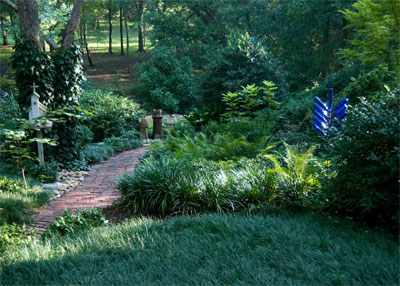From the Sperry Garden – September, 2010
People now quote what they hear me say on my radio program many times every year, "We live in a pecan forest." Hopefully, that’s decidedly clear in this photo taken from our back deck. As the trees have grown taller and wider, sunlight has all but been eliminated from the floor of that forest. And, so has our chance at lawngrass.
It’s singly the most common question I’m asked: "Neil, what’s the best grass for the shade?" My answer always begins with "How many hours of direct sunlight does the area get every day?" Four hours is the absolutely minimum for any lawngrass that we grow, and six or eight would be better. But, this part of our yard doesn’t even nudge the meter. Any given spot probably gets no more than a few minutes per day, and that’s why I’ve turned to this different approach to yard planning.
I’ll start you from the bottom. It’s the most grass-like plant that you see, which is why it goes by names such as "mondograss," "monkeygrass" and "lily turf." Some even use its genus name (Ophiopogon) as its common name. So, one plant, but at least four different names. I’ll use "mondograss" as I tell you about how dependable it’s been for me over the past 32 years. It looks like grass, and you can walk through it if you must, but you don’t mow it. It grows to 6-8 inches deep. It’s deep green, and it’s evergreen. Its small white flowers are essentially inconspicuous. I like it because it looks good immediately after you plant it. It also holds the soil tenaciously on slopes, and you can dig and divide it to start your own new plants. I’ve done that repeatedly as the trees have grown larger and the shade’s gotten deeper.
Immediately across the bark path from the mondograss ("up" in the photo), and sitting in the one spot of sunlight, you’ll find the big cousin to mondograss, giant liriope. It, too, resembles a grass, but its floral spikes are tall and lavender (white form is also available). The plant grows to 18 to 22 inches tall.
Growing right behind the liriope planting is southern wood fern. These have been here for three years, and they get better each season. They die to the ground with the first freeze, then they start anew the following spring. I’ve had them in other parts of my landscape for 25 years and longer. Great ferns.
Directly behind the wood ferns, you’ll see three stalks of a large-leafed shrub with light- to medium-green leaves. That’s a young oakleaf hydrangea. It joins probably two dozen other oakleafs around our property. Love that plant for any moist, shady location.
Directly behind the oakleaf hydrangea is a mature Nellie R. Stevens holly. This plant is 15 years old, and it’s grown to be 15 feet tall and 12 feet wide. If you look really closely just right of its apex, you’ll see the vestigal remains of our tall street lamp. It’s been engulfed by big Nellie, and I’ll be moving it somewhere this winter. Oh, and that’s another bed of shorter Nellie R. Stevens that’s peeking in to the right of my new little bottletree. You can also see the bright green leaves of our coral bark maple in the upper right corner of the photo.
The shrub in the distance, directly above the three antique English chimney pots, is plain, old-fashioned Chinese photinia. It’s actually as tall and wide as the big Nellie R. Stevens holly, and it’s still a young plant. There’s a spot of sunlight that hits its leaves much of the day. Otherwise, it wouldn’t be doing this well. I love this old-fashioned plant that you rarely see in nurseries. It’s so much nicer than its disease-prone redtip sister.
To the left of the chimney pots, you’ll see a planting of ‘Little Red’ hollies. I hope I have the name right, as I can’t find the old labels. Below them and just to the left of the left-most chimney pot, you’ll see a couple of Carissa holly shrubs. I actually use this more than any other shrub in our landscape. It grows to 30 inches tall and 36 inches wide, which is why it’s growing alongside our old street-paver walk.
And, finally, wrapping up this little tour of some of our shade, the vine growing up the pecan trunk is Persian ivy (Hedera colchica). I used to have lots of this plant as a groundcover, but this part of our yard stays wet, and I lost most of it in June 2007, when the soils were saturated for more than a month. And, no, it doesn’t harm the tree trunk at all.
My point in showing all of this, and in explaining it in all this detail, is that you don’t have to have sunlight or flowers to have a nice garden. You just have to choose carefully and take proper care of your plantings.


